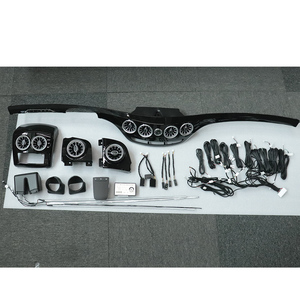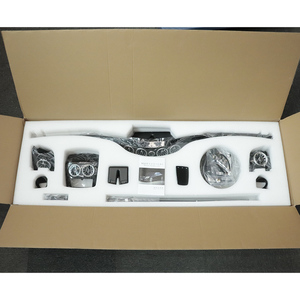(48859 products available)



















































































































 Ready to Ship
Ready to Ship

















 Ready to Ship
Ready to Ship

















































































Class 2 lighting refers to lighting systems powered by low-voltage circuits. These are usually 30 volts or less. The lighting is commonly used for safety and decorative purposes in commercial, industrial, and residential applications. Here are the types of class 2 lighting:
LED Lighting
Class 2 LED lighting is powered by low-voltage circuits. It is popular for use in safety and decorative lighting applications. The lights are energy efficient. They have high levels of brightness and long operational lives. Class 2 LED lighting systems are characterized by their flexibility and ease of customization.
Emergency Exit Lighting
These are lights installed to illuminate emergency exits in commercial and public buildings. The lights are powered by low-voltage circuits. They operate on battery backup systems. This ensures they will function in emergencies such as blackouts and power failures. Emergency exit lighting is designed to be highly visible. They feature standardized graphics and illumination levels. This ensures compliance with safety regulations and standards.
Low-Voltage Landscape Lighting
These are outdoor lighting systems powered by low-voltage circuits, typically 12 volts. They are commonly used for lighting pathways, gardens, and driveways. Low-voltage circuit lighting systems are safe for residential use. They pose minimal risks of electric shocks. They are also energy efficient. Additionally, they enhance the aesthetic appeal and security of outdoor spaces.
Class 2 Lighting Track Systems
These are lighting systems powered by low-voltage circuits. They consist of a track mounted with light fixtures. The fixtures can be moved or repositioned to suit different lighting needs. Class 2 lighting track systems are popular for accentuating artworks. They are also for dynamic lighting in retail and exhibition spaces. The systems are characterized by their versatility, ease of installation, and energy efficiency.
Neon and Cold Cathode Lighting
This type of lighting includes neon and cold lighting that operates on low-voltage circuits. These lighting systems are typically 30 volts or less. The lights are used for decorative purposes in commercial signage. They are also used for architectural accent lighting. Cold cathode and neon lighting systems are known for their long operational lives. They also have distinctive bright hues and high energy efficiency. The lighting systems enhance ambience and visual appeal in many settings.
Class 2 lighting refers to decorative lighting that is classified under electrical safety regulations. These classes determine the safety of electrical lighting based on their insulation, grounding, and risk of electric shock.
Class 2 lighting features and functions include:
Safety
Class 2 lighting is safer than others because it operates at lower voltages. This reduces the risk of electric shocks, making it safer for use in various environments. Additionally, they have double insulation. This is a feature that requires components like cables to have a protective casing. The casing prevents accidental contact with electrical parts. The casing and insulation provide electrical separation reducing the risk of short circuits.
Energy efficiency
Class 2 lighting is energy efficient. It uses low voltage LED lights that consume less power than traditional lighting. The low voltage operation of these lights makes them compatible with modern lighting control systems. This improves their energy efficiency.
Lighting control
These lights have dimming capabilities. They allow users to adjust brightness levels according to their needs. This is useful for ambient lighting for different activities in commercial and residential settings. Class 2 lights have smart lighting integration. This allows their connection to smart home systems. As a result, users can control them via voice commands or smartphone applications.
Versatility
Class 2 lights can be used for both indoor and outdoor applications. Indoor applications include decorative lighting, under-cabinet lights, and accent lights. Outdoor applications include garden lights, pathway lights, and landscape lighting. Class 2 lights come in different designs, colors, and sizes for different uses. These uses range from task lighting, accent lighting, and ambient lighting.
Easy installation
Class 2 lighting requires minimal electrical expertise. It is easy to install, making it ideal for DIY projects. They also have plug-and-play components. These lights have components that can be easily connected without complicated wiring. This reduces installation time and increases efficiency.
Low heat emission
Class 2 lighting emits low heat. This makes them safer for use in areas with flammable materials. Low heat emission also improves the longevity of the lights. It protects the structural integrity of the fixture and other nearby components.
LED lighting is used in many industries, and the demand for these lights is increasing. Buyers can use class 2 lighting in the following industries:
Assess the Lighting Needs
Determine the necessary lighting levels. For instance, higher light output may be required in areas like kitchens and living rooms. Thus, a Class 2 lighting fixture with a higher lumen output may be suitable. On the flip side, bedrooms and dining areas may require softer lighting. Therefore, fixtures with dimmable options can come in handy.
Consider Energy Efficiency
Go for options with a better energy efficiency rating. This is important for reducing electricity bills and is also good for the environment. Energy-efficient lighting, such as LED lights, provides ample brightness while consuming less power. Check the lighting's wattage and lumen output ratio. A higher ratio means it is more efficient.
Evaluate the Design and Aesthetics
Choose class 2 lighting that complements the space's interior design style. Consider factors like shape, size, color, and material. These attributes are essential for creating a visually appealing atmosphere. Also, consider the fixture's visual impact. For instance, a dramatic chandelier can be a focal point in a room. On the flip side, recessed lighting offers a sleek and unobtrusive option.
Examine the Quality and Durability
Ensure the lighting is from reputable manufacturers. This guarantees performance and longevity. Check the materials used in the lighting fixture. Options made of robust materials like tempered glass and stainless steel typically offer durability.
Review Additional Features
Look for extra features that can improve lighting flexibility and convenience. For instance, built-in dimmers permit light adjustment according to the mood or time of day. Smart lighting compatibility is another feature that allows remote control via voice commands or smartphone apps.
Q1: Can buyers use LED lights for Class 2 lighting?
A1: Yes, it is possible to use LED lights for Class 2 lighting. In this case, the LEDs will be incorporated with a plastic diffuser to help distribute light and minimize glare. Also, the LEDs will be installed in fixtures that offer structural integrity and heat dissipation.
Q2: What are the common classifications of lighting not Class 2?
A2: The lighting classifications not Class 2 are Class 1, Non-Hazardous Location, and Hazardous Location. Class 1 lighting is for areas with the possibility of explosive or flammable gases, vapors, or liquids. Hazardous Location lighting is for areas with the potential for combustible dust to exist. Non-Hazardous Location lighting is for areas that are not classified as hazardous or for other lighting needs.
Q3: What are the lighting requirements for Class 2?
A3: There are no specific requirements for Class 2 lighting. However, manufacturers must ensure the lighting does not pose any risk to users. As a result, they provide lighting with proper thermal management, electrical safety, and structural integrity. They also ensure the lighting has no more than a limited amount of energy.
Q4: What does Class 2 lighting mean?
A4: Class 2 lighting refers to devices that can be used without any special precautions or that can be used safely without any special protection. It includes lighting that can be used in locations where there is a low risk of electrical shock or where moisture, dirt, or debris may pose a risk to the device.
Q5: What are the benefits of Class 2 lighting?
A5: The main benefit of Class 2 lighting is its versatility. Since it is safer, it can be used for both indoor and outdoor applications. Class 2 lighting is also cost-effective since it requires less maintenance and fewer replacement fees due to its durability. Additionally, it offers efficient lighting, which promotes visibility and safety.
The web search volume for "class 2 lighting" in the vehicle parts and accessories category has shown a stable trend over the last year, with an average monthly web search volume of 20. Despite minor fluctuations, the overall change in web search volume over the past three months and one year remains at 0%.
Analyzing the monthly search data over the 12-month period, "class 2 lighting" experienced varied web search volumes. For instance, the volume peaked at 40 web searches in March 2024 but dipped to a low of 10 web searches in January, April, and June 2024. This pattern suggests a seasonal influence, with higher interest in March, which could be linked to specific market events or consumer behavior changes during that period.
Despite the fluctuations, the web search volume consistently returned to the average of 20 web searches per month, indicating a stable interest level among consumers. This stability could reflect a steady demand for class 2 lighting products, without significant spikes that might suggest emerging trends or shifts in consumer preference. The data highlights the importance of monitoring search trends to align marketing and inventory strategies with consumer interest patterns.